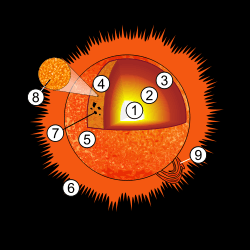Photosphere
- This article is about the astronomical object. For the image stitching feature, see Android Jelly Bean. For the solar disk in Egyptian mythology, see Aten. Not to be confused with photon sphere.

|
1. Core 2. Radiation zone 3. Convection zone 4. Photosphere 5. Chromosphere |
6. Corona 7. Sunspot 8. Granules 9. Prominence X. Solar wind |
The photosphere is a star's outer shell from which light is radiated. The term itself is derived from Ancient Greek roots, φῶς, φωτός/phos, photos meaning "light" and σφαῖρα/sphaira meaning "sphere", in reference to the fact that it is a spherical surface that is perceived to emit light. It extends into a star's surface until the plasma becomes opaque, equivalent to an optical depth of approximately 2/3.[1] In other words, a photosphere is the deepest region of a luminous object, usually a star, that is transparent to photons of certain wavelengths.
Temperature
The surface of a star is defined to have a temperature given by the effective temperature in the Stefan–Boltzmann law. Stars, excepting neutron stars, have no solid surface.[2] Therefore, the photosphere is typically used to describe the Sun's or another star's visual surface.
Composition
The Sun is composed primarily of the chemical elements hydrogen and helium; they account for 74.9% and 23.8% of the mass of the Sun in the photosphere, respectively. All heavier elements, called metals in astronomy, account for less than 2% of the mass, with oxygen (roughly 1% of the Sun's mass), carbon (0.3%), neon (0.2%), and iron (0.2%) being the most abundant.
Sun

The Sun's photosphere has a temperature between 4,500 and 6,000 K (4,230 and 5,730 °C)[3] (with an effective temperature of 5,777 K (5,504 °C))[4] and a density of about 2×10−4 kg/m3;[5] other stars may have hotter or cooler photospheres. The Sun's photosphere is composed of convection cells called granules—cells of plasma each approximately 1000 kilometers in diameter[6] with hot rising plasma in the center and cooler plasma falling in the narrow spaces between them. Each granule has a lifespan of only about eight minutes, resulting in a continually shifting "boiling" pattern. Grouping the typical granules are super granules up to 30,000 kilometers in diameter with lifespans of up to 24 hours. These details are too fine to see on other stars.
Other layers
The Sun's visible atmosphere has other layers above the photosphere: the 2,000 kilometer-deep chromosphere (typically observed by filtered light, for example H-alpha) lies just between the photosphere and the much hotter but more tenuous corona. Other "surface features" on the photosphere are solar flares and sunspots.
References
- ↑ Carroll & Ostlie (1996). Modern Astrophysics. Addison-Wesley.
- ↑ As of 2004, although white dwarfs are believed to crystallize from the middle out, none have fully solidified yet ; and only neutron stars are believed to have a solid, albeit unstable , crust
- ↑ The Sun – Introduction
- ↑ World Book at NASA – Sun
- ↑ "SP-402 A New Sun: The Solar Results From Skylab".
- ↑ "NASA/Marshall Solar Physics". NASA.
External links
- Animated explanation of the Photosphere (University of South Wales).
- Animated explanation of the temperature of the Photosphere (University of South Wales).
- Solar Lower Atmosphere and Magnetism (MPS)
